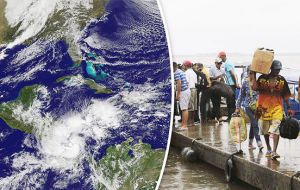MercoPress. South Atlantic News Agency
Hurricane Otto southernmost on record to hit Central America
 After Otto, is South America the next stop for the hurricane season?
After Otto, is South America the next stop for the hurricane season? Otto was by Thursday a dangerous Category 2 hurricane on a sparsely populated stretch of the Caribbean coast of Costa Rica and Nicaragua, while heavy rains from the storm were blamed for three deaths in Panama this week.
Nicaraguan authorities said Otto had damaged houses and toppled trees, but so far there were no reports of casualties. Otto battered Nicaragua's Corn Islands with 11-feet-high waves, but residents were all safe in refuges, said the archipelago mayor, Cleveland Rolando Webster.
“There is a lot of rain, the sea is rough and the wind is strong. We have been in danger all night, getting cold and wet,” said a refugee from the village of Monkey Point, south of Bluefields, Nicaragua.
The U.S. National Hurricane Center said the unusually strong late-season hurricane hit land just north of the Costa Rican border near the town of San Juan de Nicaragua with winds of 110 mph. The center said Otto's winds later weakened to 100 mph as it moved inland near the border with Costa Rica.
Otto was forecast to move across southern Nicaragua and northern Costa Rica, weakening to a tropical storm by Thursday night.
The Nicaraguan government declared a state of emergency and said evacuations would continue because of the continued risk of flooding. Nicaragua closed schools and was evacuating more than 10,000 people from communities in the storm's path. Heavy rains were expected to affect the entire country, raising the possibility of flooding and landslides.
Officials in Costa Rica ordered the evacuation of 4,000 people from its Caribbean coast and called off school nationwide for the rest of the week. Heavy rain was already causing flooding in some areas, and the president announced that public employees would not have to work Thursday or Friday.
By Thursday afternoon, Costa Rica's Emergencies Commission said 231 communities in the country's center north had been affected, of which 23 were isolated because of damage to roads and highways. Costa Rican President Luis Guillermo Solis said Otto could damage the country's important coffee and agriculture sectors.
Nicaragua also feared damage for impoverished farmers and to coffee crops that are almost ready for harvest.
Otto was moving west at 12 mph and could reemerge over the Pacific as a tropical storm before weakening to a tropical depression.




Top Comments
Disclaimer & comment rulesCommenting for this story is now closed.
If you have a Facebook account, become a fan and comment on our Facebook Page!